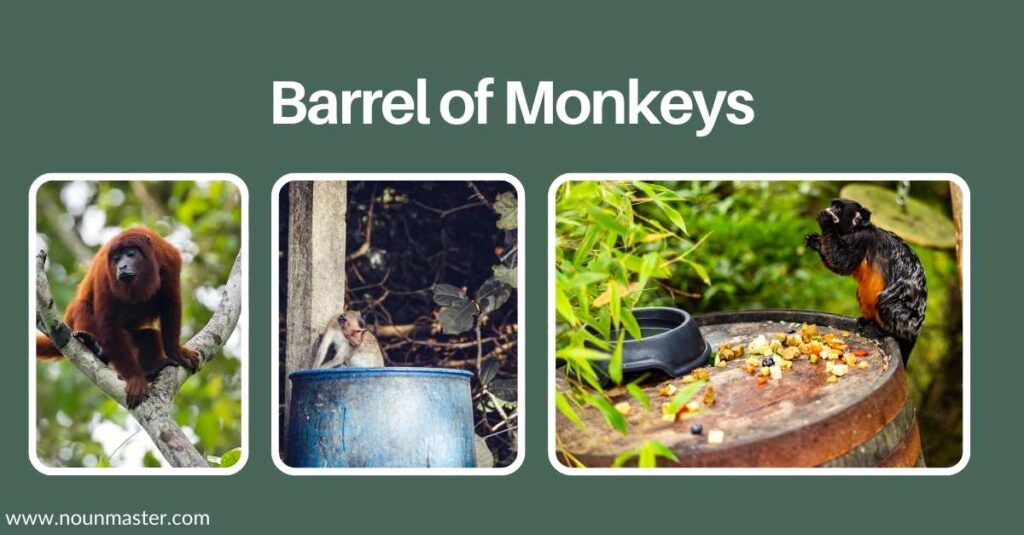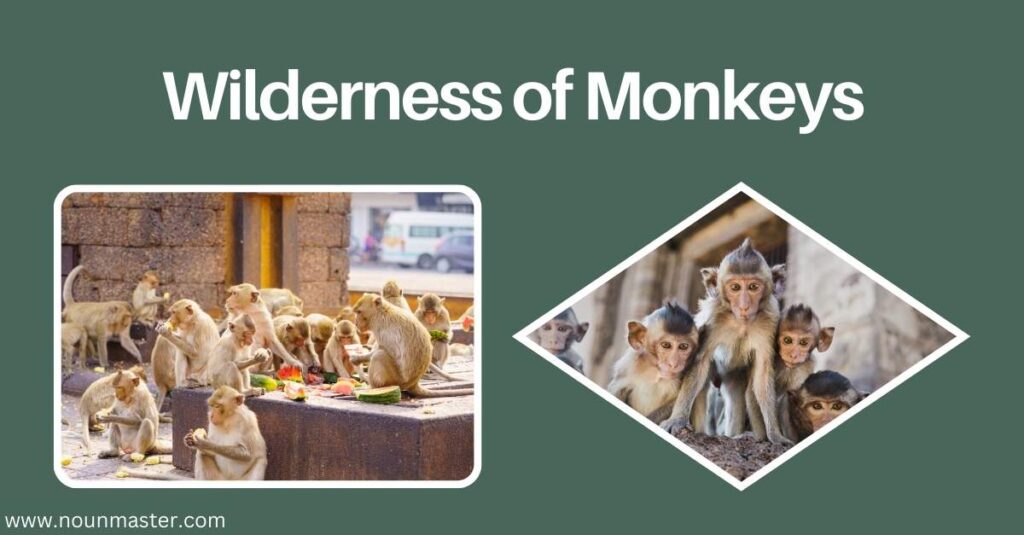Monkeys are among the most social and captivating animals, often seen in groups playing, eating, and caring for each other. The Collective Noun For Monkeys includes terms like “troop” or “shrewdness,” highlighting their social nature and teamwork in survival and support.
But did you know that when they come together, they have a unique name? A group of monkeys is called a “troop,” a term that highlights their vibrant social bonds and cooperative nature.
In this article, we’ll uncover the meaning behind this collective noun and take a closer look at how monkeys interact and thrive in their tight-knit groups.
Table of Collective Noun For Monkeys
Monkeys are social animals that often travel in groups. These groups can be called by different names depending on their behavior or environment. Here is a table of collective nouns for monkeys, along with examples to show how these terms are used in real life:
| Collective Noun | Example |
| Shrewdness | A shrewdness of monkeys cleverly stole food from the tourists. |
| Clan | The clan of monkeys worked together to find food. |
| Gaggle | The gaggle of monkeys made loud noises in the forest. |
| Carload | A carload of monkeys entertained the visitors at the wildlife park. |
| Band | The park was home to a curious band of monkeys. |
| Pack | A pack of monkeys can be very loud and active. |
These collective nouns help describe how monkeys live and work together as a group..
Group of Monkeys Is Called
A group of monkeys is called a shrewdness, clan, or troop. These terms show how monkeys live and interact in social groups. For example, a shrewdness of monkeys might gather food together, while a clan of monkeys swings through the trees as a team.
A to Z Collective Noun For Groups Of Animals
Detailed Explanations With Examples For Monkeys
Monkeys are smart and social animals that live in groups. They work together to find food, play, and stay safe. With examples, you can learn how we name these groups and understand their behavior better.
Congress of Monkeys

A congress of monkeys refers to a group of monkeys gathered together, often seen interacting, playing, or moving in unison.
Examples:
- The tourists watched a congress of monkeys gather near the river.
- The farmers tried to keep a congress of monkeys away from the crops.
- We saw a congress of monkeys playing on the temple steps.
- The children laughed at a congress of monkeys chasing each other.
- The researchers observed a congress of monkeys in their natural habitat.
Barrel of Monkeys

A barrel of monkeys is a playful term often used to describe a group of monkeys. It can also refer to something that is full of fun, mischief, or chaotic activity.
Examples:
- The toy set included a barrel of monkeys for kids to play with.
- The playful monkeys in the enclosure acted like a barrel of monkeys.
- The party felt as lively as a barrel of monkeys.
- Watching the monkeys play was like watching a barrel of monkeys.
- The team acted like a barrel of monkeys when they won the game.
Troop of Monkeys

A troop of monkeys refers to a group of monkeys that live, travel, or play together, usually in the wild or in forests.
Examples:
- The forest is home to a lively troop of monkeys.
- A troop of monkeys climbed the mountain together.
- They watched a troop of monkeys from a safe distance.
- Tourists enjoyed watching a troop of monkeys at the sanctuary.
- The zookeeper fed a troop of monkeys bananas.
Wilderness of Monkeys

A wilderness of monkeys refers to a large, lively group of monkeys, often moving together in a playful and chaotic way, resembling the wildness of nature.
Examples:
- Tourists were amazed by the wilderness of monkeys near the temple.
- The wilderness of monkeys jumped from branch to branch.
- The guide warned us not to disturb the wilderness of monkeys.
- A wilderness of monkeys chased each other across the clearing.
- The photographer captured a wilderness of monkeys in action.
Trooplet of Monkeys

A trooplet of monkeys refers to a small group of monkeys that move or live together, often interacting and playing as a community.
Examples:
- The zookeeper fed the trooplet of monkeys some fruits.
- The trooplet of monkeys rested together in the shade.
- We watched a trooplet of monkeys playing in the jungle.
- A trooplet of monkeys stole bananas from the market.
- A curious trooplet of monkeys watched the tourists from a tree.
Machination of Monkeys

A machination of monkeys refers to a group of monkeys working or playing together in a mischievous or clever way, often showing their intelligence and curiosity.
Examples:
- The zookeeper watched a machination of monkeys plot to escape.
- Children watched a machination of monkeys interact at the zoo.
- The tourists laughed at a machination of monkeys playing tricks on each other.
- In the jungle, a machination of monkeys surrounded the campsite.
- The villagers saw a machination of monkeys raiding their fruit garden.
Cartload of Monkeys

A cartload of monkeys refers to a group of monkeys, often playful and active, imagined as if they are filling a cart due to their number or behavior.
Examples:
- The zoo keeper said managing a cartload of monkeys is challenging.
- The forest was alive with the chatter of a cartload of monkeys.
- We laughed as a cartload of monkeys played with each other.
- The movie featured a cartload of monkeys causing trouble in the city.
- The children compared their noisy classroom to a cartload of monkeys.
Final Thought
When it comes to monkeys, a group is called a ‘troop,’ and this name perfectly captures their lively, social nature. Monkeys are known for their teamwork—whether it’s for finding food, protecting one another, or raising their young, a troop is vital to their survival.
Learning this term not only helps us understand how monkeys communicate and cooperate but also highlights the fascinating social dynamics that exist in the animal kingdom. A troop isn’t just a group; it’s a reminder of the deep connections that animals form to thrive together.
Doctor Is Which Type of Noun? Learn About Collective Nouns for Doctors







